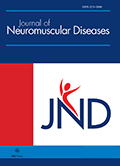Authors: Fatehi, Farzad | Advani, Soroor | Okhovat, Ali Asghar | Ziaadini, Bentolhoda | Shamshiri, Hosein | Nafissi, Shahriar
Article Type:
Research Article
Abstract:
Background: Muscle MRI protocols have been developed to assess muscle involvement in a wide variety of muscular dystrophies. Different muscular dystrophies can involve muscle groups in characteristic patterns. These patterns can be identified in muscle MRI in the form of fatty infiltration. Objective: This study was conducted to add the existing knowledge of muscle MRI in GNE myopathy and evaluate the correlation of muscular involvement with different gene mutations. Methods: The MRI scans of the 18 GNE patients were analyzed retrospectively. Cluster analysis was done for grouping the muscles and patients. Results: The four
…muscles with the highest fat infiltration were adductor magnus, tibialis anterior, semitendinosus, and semimembranosus. Furthermore, three clusters of muscle involvement were found, including cluster 1, typical muscle involvement indicating muscles with the highest infiltration: extensor digitorum longus, gracilis, biceps femoris, soleus, gastrocnemius medial, adductor longus, tibialis anterior, adductor magnus, semimembranosus, semitendinosus; cluster 2, less typical muscle involvement indicating muscles with intermediate fat infiltration, peroneus longus, gastrocnemius lateral, and minimal fat infiltration in most of the patients, i.e., tibialis posterior; and cluster 3, atypical muscle involvement with low-fat infiltration: rectus femoris, sartorius, vastus intermedius, vastus medialis, and vastus lateralis. Conclusions: This study found three clusters of muscle involvement and three groups of patients among GNE patients. Hamstring muscles and the anterior compartment of the lower leg were the muscles with the highest fat infiltration. Moreover, a weak genotype-muscle MRI association was found in which tibialis posterior was more involved in patients with the most frequent mutation, i.e., C.2228T > C (p.M743T) mutation; however, this finding may be related to longer disease duration.
Show more
Keywords: Muscle MRI, GNE myopathy, Nonaka myopathy, h-IBM2
DOI: 10.3233/JND-210629
Citation: Journal of Neuromuscular Diseases,
vol. 8, no. 4, pp. 735-742, 2021
Price: EUR 27.50





